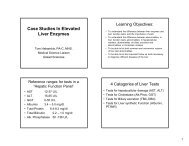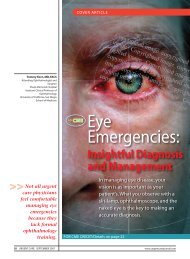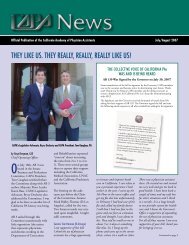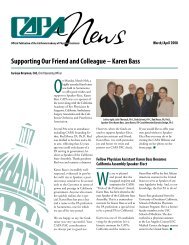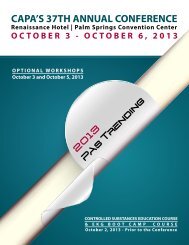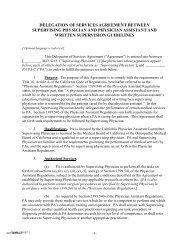Read More - California Academy of Physician Assistants
Read More - California Academy of Physician Assistants
Read More - California Academy of Physician Assistants
You also want an ePaper? Increase the reach of your titles
YUMPU automatically turns print PDFs into web optimized ePapers that Google loves.
So When Do I Get My Fluoroscopy Permit?<br />
by Bob Miller, PA, Pr<strong>of</strong>essional Practice Chair<br />
Many <strong>of</strong> you may vaguely<br />
remember something about<br />
CAPA supported legislation<br />
that was passed a few years ago to<br />
allow PAs to obtain a fluoroscopy<br />
permit. Your long-term memory is<br />
intact - we just haven’t gotten there<br />
yet.<br />
Assembly Bill 356 (Fletcher) passed<br />
and was then signed by the Governor<br />
and filed with the Secretary <strong>of</strong> State<br />
on October 11, 2009. Although this<br />
legislation created a pathway for PAs<br />
to use fluoroscopy, there were no<br />
existing regulations to address the<br />
provisions specified in AB 356. So<br />
with the law in place, regulations<br />
were then required to describe how<br />
AB 356 should be implemented<br />
to define the procedures to obtain<br />
and renew a permit and to specify<br />
the expanded scope-<strong>of</strong>-work for a<br />
PA. At this writing, the <strong>California</strong><br />
Department <strong>of</strong> Public Health has<br />
developed regulatory language which<br />
is now in a public comment period<br />
to end on January 14, 2013. If<br />
there is no opposition to the current<br />
language it will continue to move<br />
forward without the need for more<br />
public hearings. We are not aware <strong>of</strong><br />
opposition at this point and CAPA<br />
has submitted a letter <strong>of</strong> support.<br />
We still need to wait for final <strong>of</strong>ficial<br />
completion <strong>of</strong> the regulatory process,<br />
however we hope the new regulations<br />
will be finalized soon. While we<br />
are waiting, here are some <strong>of</strong> the<br />
main points contained within the<br />
new regulations (which could still<br />
change).<br />
Briefly, as proposed, the new<br />
regulations would:<br />
1) Define eligibility criteria<br />
for a PA to apply for a PA-<br />
Fluoroscopy permit, such as<br />
holding a current PA license<br />
and recognizing PAs in the<br />
definition <strong>of</strong> a “licentiate”.<br />
2) Establish a more compact set<br />
<strong>of</strong> educational and clinical<br />
requirements to include a 40<br />
hour didactic course followed<br />
by 40 hours <strong>of</strong> clinical training<br />
(on the job) with appropriate<br />
supervision and reporting<br />
criteria.<br />
3) Define requirements for<br />
delegation <strong>of</strong> procedures<br />
within the DSA and for<br />
appropriate supervision by<br />
physicians who must also hold<br />
a current fluoroscopy permit.<br />
This places the practice site<br />
with the determination <strong>of</strong> what<br />
the PA will be authorized to do<br />
within the permit limitations.<br />
4) Require a minimum <strong>of</strong> 10<br />
hours <strong>of</strong> continuing education<br />
to renew the permit every two<br />
years.<br />
5) Define who may <strong>of</strong>fer<br />
the didactic and clinical<br />
training and guidelines for<br />
documentation <strong>of</strong> completion.<br />
Continued on page 4
So When Do I Get My Fluoroscopy Permit?<br />
Continued from page 3<br />
6) Establish the fees associated with initial permit application and<br />
renewal.<br />
The addition <strong>of</strong> these regulations actually establishes a second<br />
pathway for PAs to obtain a fluoroscopy permit. As stated above,<br />
this new pathway is an abbreviated educational approach as a now<br />
defined “licentiate” (previously limited to those with a MD, DO,<br />
DC and DPM). The currently existing pathway is to complete<br />
a two-year course to become a certified radiologic technologist<br />
(CRT) and then complete approximately 55 hours to obtain a<br />
fluoroscopy permit. This current pathway would allow for a much<br />
wider expansion <strong>of</strong> scope <strong>of</strong> practice because the duties <strong>of</strong> the CRT<br />
are not tied to the PA license. My guess is most PAs will go for the<br />
abbreviated approach.<br />
The above is just an overview <strong>of</strong> proposed regulations. Once they are<br />
final, we will place more complete updates in the CAPA News and<br />
the on the CAPA website. •<br />
Robert Miller, PA<br />
CAPA Pr<strong>of</strong>essional Practice Committee Chair<br />
… your host on an enlightening series<br />
<strong>of</strong> videos depicting the history <strong>of</strong><br />
physician assistant practice in <strong>California</strong><br />
and the evolution <strong>of</strong> the <strong>Physician</strong><br />
Assistant Practice Act.<br />
• PA Scope <strong>of</strong> Practice<br />
• Prescriptive Authority and Protocols<br />
• Laws and Regulations<br />
• The Surgical PA<br />
• Reimbursement Issues<br />
• The New PA and the New Job<br />
CAPA Members Can View<br />
the Videos On-line at<br />
www.capanet.org



